
Galium verum is a herbaceous perennial plant of the family Rubiaceae. It is widespread across most of Europe, North Africa, and temperate Asia from Palestine, Lebanon and Turkey to Japan and Kamchatka. It is naturalized in Tasmania, New Zealand, Canada, and the northern half of the United States. It is considered a noxious weed in some places.

Galium album, the white bedstraw or hedge bedstraw, is a herbaceous annual plant of the family Rubiaceae.

Galium angustifolium is a species of flowering plant in the coffee family known by the common name narrowleaf bedstraw. It is native to California and Baja California, where it is most commonly found at low elevations in the mountains.
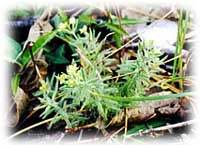
Galium californicum is a species of flowering plant in the coffee family known by the common name California bedstraw.
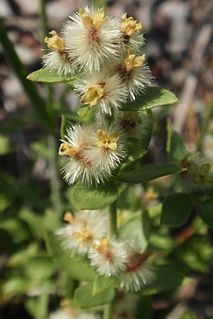
Galium grayanum is a species of flowering plant in the coffee family known by the common name Gray's bedstraw. It is native to the high mountains of northern California, western Nevada and southwestern Oregon.
Galium matthewsii is a species of flowering plant in the coffee family known by the common names bushy bedstraw and Matthews' bedstraw. It is native to the mountains and deserts of southeastern California, and southern Nevada.

Galium multiflorum is a species of flowering plant in the coffee family known by the common names Kellogg's bedstraw, shrubby bedstraw, and many-flowered bedstraw. It is a perennial herb that grows on rocky soils, mountains, and desert slopes.
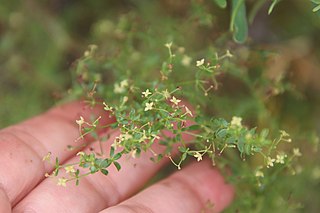
Galium porrigens is a species of flowering plant in the coffee family known by the common names graceful bedstraw and climbing bedstraw. It is native to the west coast of North America from Oregon to Baja California.
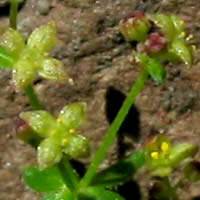
Galium nuttallii is a species of flowering plant in the coffee family known by the common names San Diego bedstraw and climbing bedstraw. It is native to the coast and coastal Peninsular and western Transverse Ranges of southern California and Baja California, where it is a member of chaparral and pine woodland plant communities. It is also found on the Channel Islands and on the mainland as far north as Santa Barbara County
Galium glabrescens is a species of flowering plant in the coffee family known by the common name Castle Lake bedstraw. It is native to the mountains of far northern California and southern Oregon, including the Klamath Mountains.
Galium hypotrichium is a species of flowering plant in the coffee family known by the common name alpine bedstraw. It is native to the western United States, where it grows in mountain and plateau habitats, including parts of the Great Basin and Sierra Nevada in California, Nevada, and Utah.

Galium parisiense is a species of flowering plant in the family Rubiaceae known by the common name wall bedstraw. A native of the Mediterranean area and Western Europe, it has become naturalised in North America and other parts of Europe.

Galium serpenticum is a species of flowering plant in the coffee family known by the common name intermountain bedstraw or many-flowered bedstraw. It is native to the northwestern United States, where it grows in mountain forests and meadows, mostly east of the crest of the Cascade Range. It occurs in Washington, Oregon, Idaho and extreme northern California.
Galium sparsiflorum is a species of flowering plant in the coffee family known by the common name Sequoia bedstraw. It is endemic to California, where it grows in shaded habitat in certain mountain ranges, including the Sierra Nevada.

Galium trifidum is a species of flowering plant in the coffee family, known by the common name three-petal bedstraw. It grows widespread in the arctic, temperate and subtropical regions of the Northern Hemisphere: northern and central Asia, northern and eastern Europe and much of North America.
Galium magnifolium is a species of plants in the Rubiaceae. It is native to California, Arizona, Nevada, and Utah.

Galium mexicanum is a species of plant in the family Rubiaceae. It has a widespread distribution from British Columbia south to Ecuador.
Galium muricatum, Humboldt bedstraw, is a species of plant in the Rubiaceae. It is native to northwestern California and southeastern Oregon.
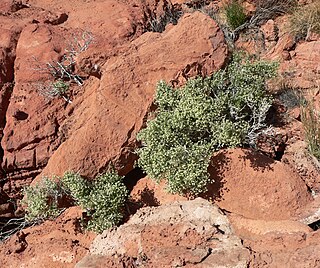
Galium stellatum is a species of plant in the family Rubiaceae. It is widespread across most of Arizona, and found also in Baja California, Baja California Sur, southeastern California, Nevada, Utah. It is dioecious, with male and female flowers on separate plants.

Galium wrightii, common name Wright's bedstraw, is a species of plants in the Rubiaceae. It is native to northwestern Mexico and southwestern United States: Sonora, Chihuahua, Arizona, New Mexico, western Texas, southwestern Utah, southern Nevada and southeastern California In California, this plant is ranked as rare, threatened, or endangered in CA; common elsewhere.













